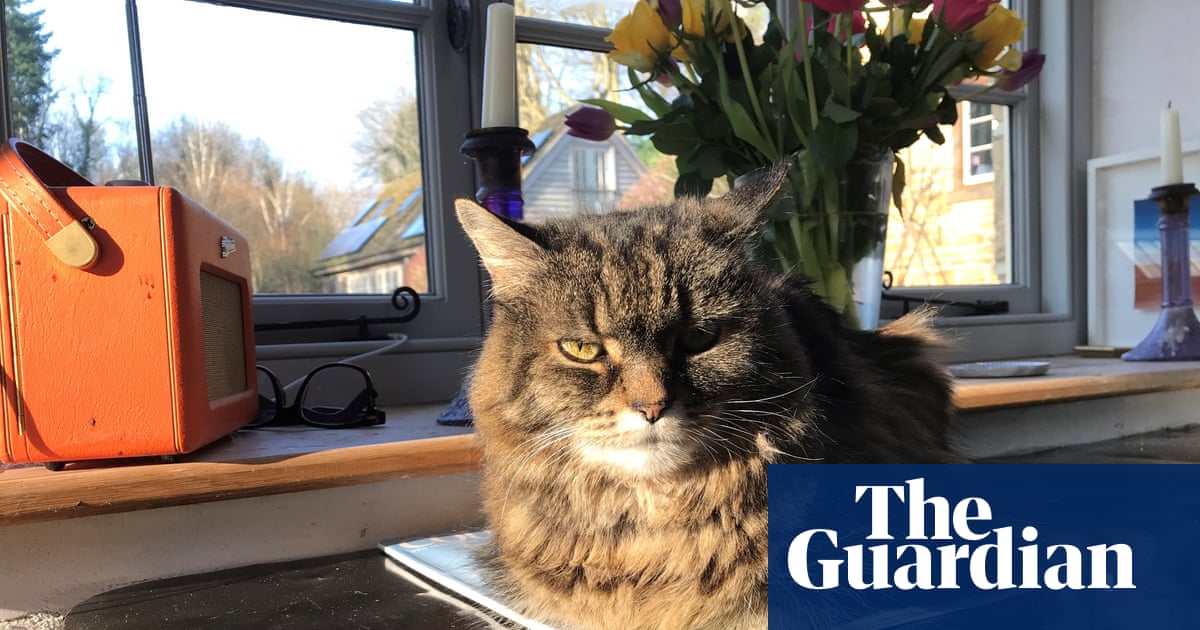
hen I last spoke to Rachel Whiteread, I declared loftily that she would always make casts, that she’d never do anything else. Because that’s what she’d been doing for more than 30 years; that was her language. She began by casting the void under a chair, then she cast the gap under a bed. She cast tiny, humble things – the interior of hot-water bottles, resembling little human torsos. She went huge, casting an entire room, then a house in Bow, east London. That won her the 1993 Turner prize: she was the first woman and the youngest artist ever to do so, aged just 30. She went on to cast rows of bookshelves, and fashioned them into the grave, bunker-like Holocaust memorial in Vienna. She won London’s Fourth Plinth project, and elegantly skewered the entire monumental enterprise by casting the plinth itself in icy, translucent resin and inverting it.
None of this has been particularly peaceful. House became a lightning rod for angry debates, not just about contemporary art, but housing policy, communities and regeneration. It took her two years to get it done and, despite campaigns for a stay of execution, the work stood for a mere six weeks. Beset by politics and heartily opposed in some quarters, the Holocaust memorial took five years. “I’m very glad I made it,” she says, “but I wouldn’t want to go through anything like that again.” It is hardly surprising that, in recent years, she’s made what she calls “shy sculptures” – a version of a Nissen hut in a forest in Yorkshire, cabins in the Mojave desert, a boathouse on a Norwegian fjord, a shed on Governors Island in New York. These are reclusive things; experiencing them requires a quest. And they are all, one way or another, casts.
Well, that has changed. Whiteread has made two major new works, now on view in London. And they aren’t casts. After 35 years, she has completely changed her language, or rather “expanded my vocabulary”. She’s built two huts – yes, there’s a continuity – from reclaimed wood, bits of trellis and metal, old planks and twisted boughs. Painted white, so the light bounces off them, they are almost ghostly. They seem like buildings some disaster has ripped through – a hurricane, or a flood.
Looking at the new works, I thought of the climate crisis, of unpredictable weather, of refugee camps, of pandemics – the fragility of things in general. “We’ve all felt it,” she agrees. “The security of the world as we knew it has been thrown on its head.” Making the new work echoed that state of deep uncertainty. When casting, she says, “you have to know exactly what you are doing in advance. I am so used to imagining space by looking at something and imagining what it’s going to look like back to front. That’s how I think. To do this was almost the opposite.” She was making it up as she went along, inventing, improvising, backtracking, busking.
When I saw Whiteread on that previous occasion in her studio, in 2019, while her mid-career retrospective was touring the world,, she showed me images of buildings torn down by Hurricane Katrina, which devastated New Orleans in 2005. “At the time I had this mantra in my head of wanting to make the opposite of what I had always been making,” she says, Covid-jabbed and distant, across an antiseptic white office in London’s Gagosian gallery. “At that time, I couldn’t work out what it was, but I kept collecting all this material.”
Beachcombing, picking up discarded things, is a habit from childhood, passed down by her artist mother and geographer father. “There’s always something in the back of the car. The kids are like, ‘Oh, really? Please don’t pick that up, Mum, it’s embarrassing.’” (She and her husband, Marcus Taylor, have two sons.) Whiteread tried casting some of these finds – fencing, corrugated iron – but it wasn’t working. “So I started nailing things together and painting them.” She’s always done a lot of drawing, and she realised that she could use stuff she’d found to draw – but in three dimensions. She could make “big drawings of the skin and bones of buildings; of flayed buildings; of things after disasters”.
Whiteread, who turns 58 later this month, is a quiet, contained presence. Occasionally, though, in the midst of being straightforward and practical, she’ll say something quite wonderful. On a recent podcast, she described poetry as “the sound of words touching each other”. She laughs when I remind her. “That’s quite good, isn’t it?” She describes the new work as “the touch of material against air. The thing that’s different about them is the airiness, I think.” Unlike the dense presence of the casts: “memory made solid”, as she once described them.
Called Poltergeist and Doppelgänger, the two ruined huts form a contrast. “Poltergeist looks as if it’s been pulled up by something,” she says. “Doppelgänger looks like it’s been stamped on.” One of her very earliest sculptures was called Ghost. It was a cast of the interior of a wardrobe, made in 1990 when she was 27. She has always been a very careful namer of her works, so I read Poltergeist as a deliberate echo. Just as Ghost was a statement of intent, the laying down of a language, so too is Poltergeist. The contrast between the two, though, is strong. A poltergeist is different from a ghost: mischievous, malign. “Noisy,” says Whiteread, with a smile. In German folklore, a doppelgänger is also an uncanny thing: the wraith or apparition of a living person. Despite the evident formal control, there is something wild and unsettling in the new work I haven’t seen in her before. They remind me of Louise Bourgeois works, where she summons up the idea of a home but infuses it with something dark and unruly.
When Whiteread showed the sculptures to a friend. An old resin cast of hers was standing nearby. “He said, pointing at the cast, ‘That’s your calm poetic side.’ And he pointed at Poltergeist and said, ‘That’s your nuts side.’ And that’s exactly right. There’s an essence of me in there that I’ve not really explored before.” She pauses. There’s something else, she says.
“I was diagnosed as bipolar eight years ago. It is interesting to say that out loud. It’s not something I’ve talked about publicly. To get that diagnosis at 50 – and I’ve been hospitalised a few times – it brought a sort of clarity to things I had never had before.” She has always been an “emotional sponge”, she says. “A thing can happen and you sort of unravel.” In the past, she says, she wouldn’t have felt comfortable talking about the condition. But, she adds, “It’s a good thing for people to know that people like me – successful people – can be very ill.” These new works are part of her reaching an accommodation with the diagnosis, even harnessing it. “I’m now able to take a step back and say, ‘I know what’s going on.’ And not compartmentalise it, but to understand and use it in some way. It’s fed into my creativity in a way which I think is clear.”
We talk of other things. I’m curious to know her thoughts about the calls to build a monument commemorating Covid-19. In London, on the Thames embankment opposite the Palace of Westminster, the National Covid Memorial Wall has sprung up – an official-sounding name for something that is in fact informal, the brainchild of a campaign group, the Covid-19 Bereaved Families for Justice. It consists of hearts drawn on to the wall by volunteers, each representing someone lost. It’s communitarian, modest and very moving. I’d seen it the evening before, so show Whiteread some pictures. “That’s beautiful,” she says, swiping through. “Do I think it should be fixed in time, made permanent? I think it should be left just to be and then gradually disappear. To have its quietness.”
What about some more lasting marker? “You can’t memorialise something that’s still going on,” she says. “You need to have some time and distance to think about what it was.” She says she has turned down all kinds of approaches to make memorials. She was even approached to submit ideas for Ground Zero in New York. She just couldn’t consider it: too soon. Instead, 15 years after 9/11, she made the melancholy, quiet work Cabin on Governors Island, which looks directly out to the twin towers site. It’s much more oblique and open-ended than a straightforward memorial.
She has form, of course, with the official urban monument, and is proud of the Vienna Holocaust Memorial. “It’s really doing its job,” she says. Which is what? “Well, in Vienna it’s job is to be clear about what happened. There was an awful lot of fuzziness around various issues. Kids didn’t really know what had happened.” She’d never have done it, though, without having spent years thinking about the war and the Holocaust. A friend of her parents’, when she was growing up in Essex and London, was a survivor of the concentration camp Belsen, and he told his stories. Then, in the aftermath of the Turner prize, she went to live in Berlin for a while, and thought deeply about the legacy of the Holocaust, reading widely and visiting camps. “If I hadn’t have done that, I would never have attempted to make a memorial, or comment on it.”
I wonder too about her take on the current culture war over statues, stoked in England by Tory ministers. What does she think should happen to memorials to slave traders and imperialists? She has no magic answer. “I’m not sure what one does with them. I don’t think they should be melted down. I think they need to be commented on. Maybe that means taking them out of their spot and putting them in a museum. I’m not sure that’s a good thing – but it’s a more easily digestible way of dealing with it.” But, as she points out, it’s a pretty rare problem. “Let’s face it, most of these bronze sculptures, no one’s got a fucking clue who they are, what they did or why they did it.”
She certainly doesn’t think the answer is not to put up a whole load more statues, to “balance out” representation. “Isn’t there a more interesting way of looking at someone than a bust, or a figurative version of them that frankly often isn’t very well drawn or sculpted?” That kind of statue belongs to the past, she thinks, to the pre-photographic age. “The world has moved on and I think we need to continue moving on.”
We turn our attention back to her sculptures. She’s itching to do more. “It’s just the beginning of the adventure,” she says. It has been liberating: less of an intellectual journey than the casts, more intuitive – a case of discovering uncharted territory. The nautical phrase makes me remember that I once saw on her studio wall a postcard of The Raft of the Medusa by Géricault. It’s still there, she says. If her casts are poised, formal and controlled, echoing the rhythmic rooms and deep perspective of her favourite Renaissance painter, Piero della Francesca, then the new sculptures have more of the spirit of Géricault’s shipwreck masterpiece – and of our uncertain, terrifying times. Like those stricken sailors, the works seem to say, we are all just clinging on, trying to survive.
Rachel Whiteread’s new exhibition, Internal Objects, runs at Gagosian, London, from 12 April to 6 June.












